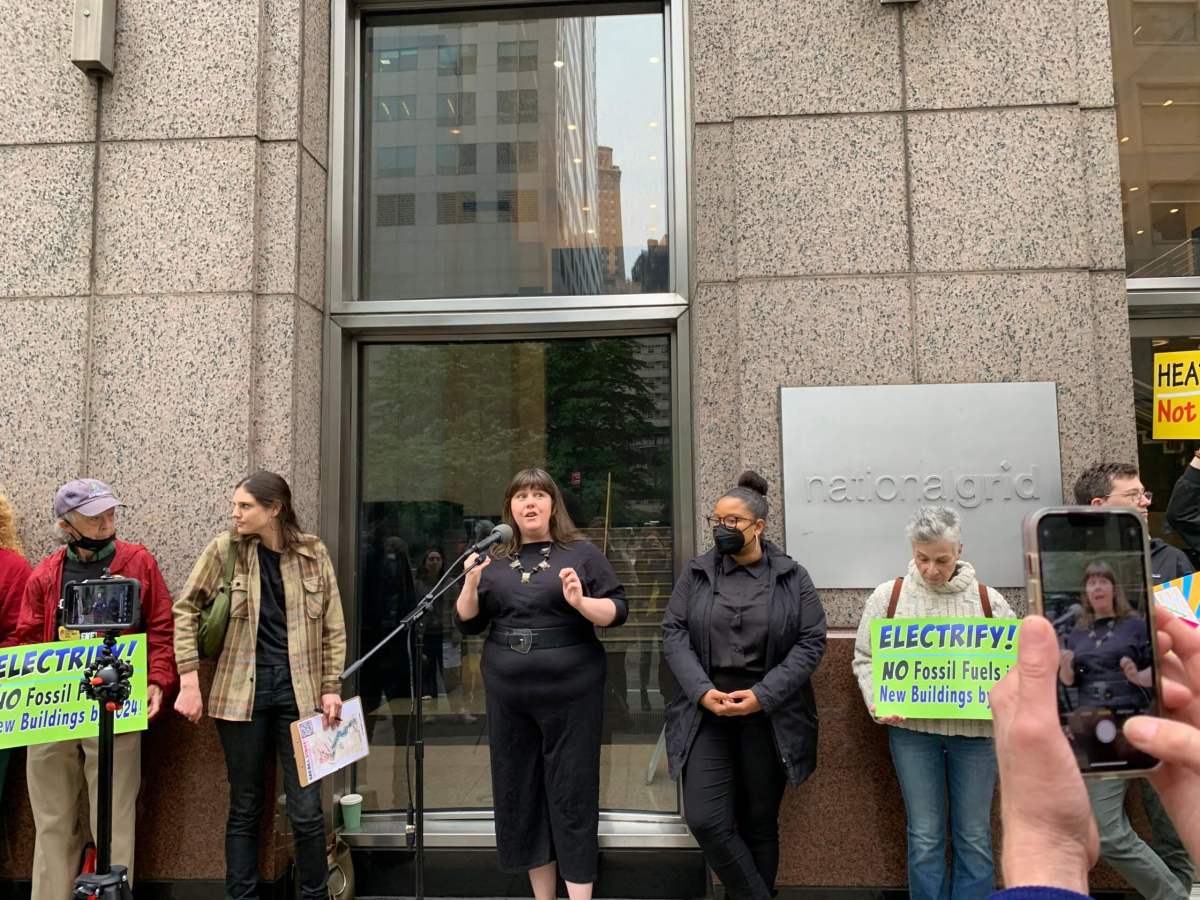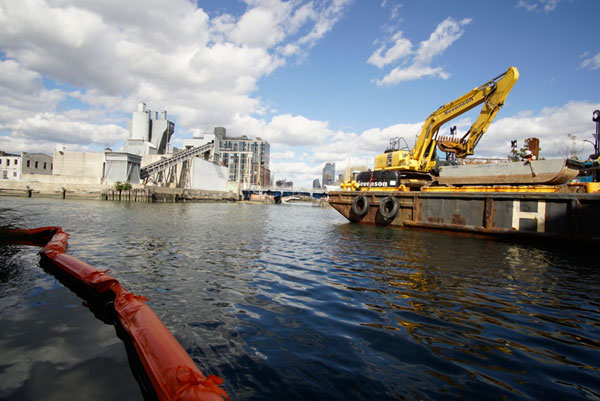With just weeks left in the state’s legislative session, Brooklyn elected officials and environmental activists are calling for the passage of critical climate-centered bills — and for utility giant National Grid to change its tune on state climate goals.
New York’s State Senators and Assemblymembers will head home for the next six months on June 2, leaving any yet-to-be-passed legislation in limbo until they reconvene next year. Among this year’s remaining bills are a trio of laws seeking to reduce the greenhouse gas emissions associated with homes and buildings and speed the transition to renewable energy.
At a rally outside of National Grid’s headquarters in Downtown Brooklyn on May 19, Assemblymember Emily Gallagher, who represents a swath of North Brooklyn, said the communities she represents have been hit hard by the legacy of oil companies.
“This is a community that, as you know, has centuries of abuse by National Grid and its predecessors,” Gallagher said. “Polluting our ground and our water and causing long-term health damage to the community members for decades.”
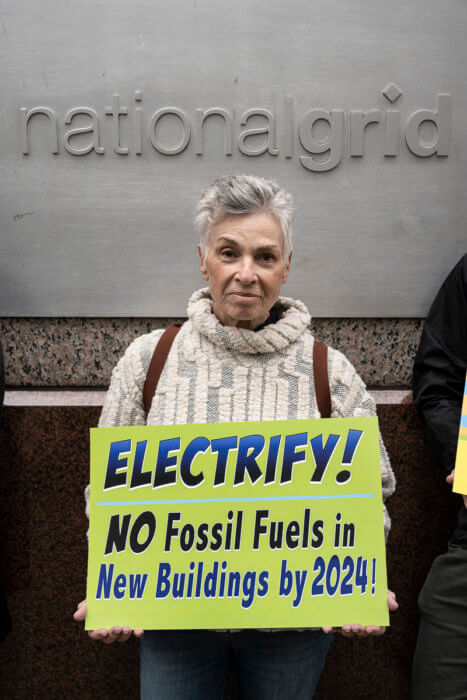
Named a responsible party by the federal Environmental Protection Agency, the British utility giant is on the hook for funding cleanup of two of Brooklyn’s federal Superfund sites, the Gowanus Canal and Newtown Creek, because it owns the companies that polluted the sites decades ago.
Starting in 2017, the company built the first four stages of the controversial North Brooklyn Pipeline, which many say is a serious health and safety risk to the neighborhoods it passes through.
In part because of that history, Gallagher is sponsoring the “All-Electric Building Act,” which would require all new buildings statewide be all-electric and without gas hookups. If passed, heat systems, appliances, and other utilities would have to be fully electric in new buildings starting in 2024.
The bill is one of three Gallagher and the Renewable Heat Now coalition were championing on Thursday. All three laws focus on reducing emissions associated with homes and buildings and making the switch to renewable energy.
“This is not just an idea that is appealing to me,” Gallagher said. “We have 43 co-sponsors. They span the entire state.”
Lawmakers push to vote on climate legislation
Buildings are the source of more than half of New York City’s annual carbon emissions, With both the city and the state promising to dramatically reduce their carbon emissions by 2050, reducing the number of buildings relying on natural gas and pumping up renewable energy resources is critical to meeting those goals.
Gallagher said she and her colleagues have been told time and time again in hearings that the technology needed to make the All-Electric Building Act a reality is both cost-effective and ready to launch, but she’s still fighting to get it rubber-stamped before time runs out.
Brandon Medina, an organizer with Sunrise Movement NYC, said he and his colleagues have worked tirelessly to pass climate legislation, each time feeling like they might make some real progress — only to have their hope snubbed by the end of the legislative session.
“We’ve been picking up momentum, but our window is closing,” he said. “The past six months have not been a waste. We have the votes, now we just need to put it to a vote on the floor.”
Part of the problem is the legislature’s leadership, Gallagher told Brooklyn Paper. Assembly Speaker Carl Heastie has to decide to put the bill on the agenda so the body can take a vote.
“I think there needs to be a lot of pressure on the speaker,” she said. “At the end of the day, the leadership can do what they want to do, and they can pass the bills that they want to pass. We’ve seen it time and time again.”
But Gallagher, Medina, and the Coalition say there’s another significant obstacle to getting the bills passed and to implementing the goals of the state’s Climate Leadership and Protection Act — companies like National Grid.
Misinformation and the CLCPA
Last month, a new commercial aired on television screens across New York State warned viewers that the state was pushing a new energy plan “Most New Yorkers haven’t heard about,” claiming Albany wanted to ban gas appliances and leave households with a $30,000 bill to buy new ones.
The commercial was sponsored by a group called New Yorkers For Affordable Energy, backed by a long list of supporters like trade unions and local councils — and some of the state’s most significant fossil fuel dependent energy companies, including National Grid, Danskammer Energy, and The Williams Companies.
The misleading ad started airing at a critical juncture for climate law in New York. Advocates were pushing for both the All-Electric Building Act and the Build Public Renewables Act to be included in the state budget as negotiations with Governor Kathy Hochul drew to a close, and the state’s Climate Action Council was about to hold its first public hearing.
Composed of political leaders and climate experts, the CAC is responsible for deciding how New York will actually achieve the goals laid out in the CLCPA. In a series of public hearings held from April 5 to May 12, the council took feedback on their preliminary Draft Scoping Plan.
During those hearings, National Grid continued to misrepresent the CLCPA and their own plans, advocates said at the rally, accusing the company of attempting to undermine the law.
But, in a statement, National Grid said it “fully supports” the goals of the CLCPA, and took part in the hearings to “an affordable, reliable way that protects customer choice.”
According to their “Clean Energy Vision,” released last month, the company plans to transition their gas and electric systems completely off of fossil fuels by 2050, relying instead on renewable natural gas and green hydrogen.
There is “a lot of good” in the Draft Scoping Plan, said Karen Young, a National Grid spokesperson, but the company feels the current plan is too heavily dependent on full electrification — the utility estimates that 60 percent of existing buildings will not be able to electrify.
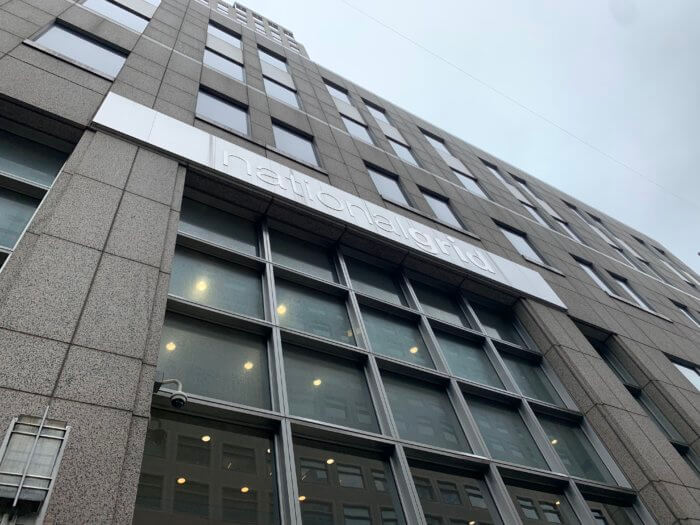
“National Grid knows we will electrify a lot of buildings; however, it cannot be the only solution and we have put forth a pathway that provides a better way that leads with increased energy efficiency to help reduce demand, targeted electrification with networked geothermal, and renewable natural gas and green hydrogen to decarbonize the existing gas system,” she said.
The company’s current gas infrastructure is compatible with the alternative fuels, she said, and National Grid has been using RNG in its systems for about 30 years. After the Clean Energy Vision was announced, the company put out a “request for information,” to producers and developers, seeking more information about the availability of RNG and hydrogen.
Young also said National Grid plans to produce RNG at its Newtown Creek plant. Made from biogases produced by landfills, livestock farms, and wastewater treatment plants, RNG can reduce emissions associated with those operations and improve local air quality, according to the EPA.
A biogas purification project at Newtown Creek is years behind schedule, with gas that would be processed and injected into National Grid’s systems being burned off, releasing carbon dioxide into the atmosphere.
A realistic path to reducing emissions
Activists say National Grid’s plans are unrealistic.
According to a 2021 paper from the Rockefeller Institute of Government, a very small amount of New York’s biogases are collected each year, and even less is purified into biogas. Even with production ramped up 100 percent, RNG would meet only five percent of the state’s annual fossil fuel demand.
“There’s not an existing supply at all equal to the scale at which National Grid is planning to use it,” said Allison Considine, a Sierra Club representative. “Everyone from power plant operators to utilities like National Grid to aviation companies and industrial applications are all saying ‘Oh, we need to decarbonize, New York has this climate law, we’ll use biomethane, we’ll use renewable natural gas, rather than electrifying.”
Avni Pravin, deputy policy director at the Alliance For a Green Economy, said fears of electrification causing bills to increase or heat sources to fail are unfounded and untrue. Price volatility is “baked into” gas and oil heating, she said, while homeowners who have transitioned to heat pumps and other non-fossil fuel utilities often save money.
It’s also important, she said, to make clear that the current plan, and the All-Electric Building Act, is focused only on new construction starting in 2024 — not retrofitting or making changes to existing buildings or trying to rip out people’s gas stoves.
She also noted that hydrogen blending, one of the solutions proposed by National Grid, could force individuals to replace their appliances and companies to upgrade their infrastructure — many existing pipelines and appliances are not suited to high levels of hydrogen.
City electeds step in to enforce climate laws
Several of Brooklyn’s local council members joined forces on Thursday to introduce a City Council resolution in support of the Draft Scoping Plan and calling on Hochul to implement the emissions standards set in the CLCPA.
“We don’t have climate goals in New York, we have climate mandates,” said Councilmember Lincoln Restler, ahead of the council’s stated meeting where the resolution was formally introduced. “That is what the CLCPA lays out. Let me tell you this, it is time to end our reliance on fossil fuels.”
Restler called on National Grid should “stop the greenwashing,” saying electrification and technology like heat pumps are the way forward.
“National Grid’s Clean Energy Vision is predicated on what the environmental justice community calls ‘false solutions,’ which do not reduce our reliance on fossil fuels and which further harm the health and well-being of our communities,” said Jasmine Graham, a policy manager at WE ACT for Environmental Justice.
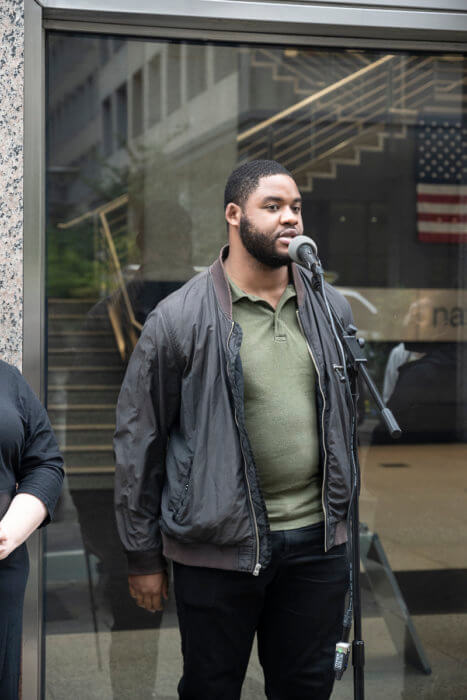
Graham said additional supply of RNG would “inevitably” be trucked through Black and brown neighborhoods, which are already subject to disproportionate amounts of dangerous transportation pollution.
Gallagher encouraged people to make their voices heard before the end of the legislative session to try to get the bills passed.
“It really does impact [the process] when you speak up and you get involved, so, you can take the time to make a phone call or write an email, it takes about ten minutes,” she said. “You can do it from your phone, and it will make a big impact.”
Fabian Rogers, a constituent advocate from state Sen. Jabari Brisport’s office and a member of Brownsville Green Justice, said the communities most impacted by climate change and fossil fuel infrastructure are also unlikely to have the time, support and resources to be part of the conversations with companies like National Grid.
“I know this is a very tiresome sort of effort, I know this is a lot to take in,” he said. “I appreciate the pressure that you all are putting on because it’s far, far, far too essential for a better tomorrow, for an actual clean future for all people in New York State and New York City. Not just for people who don’t look like me, but for everybody.”


